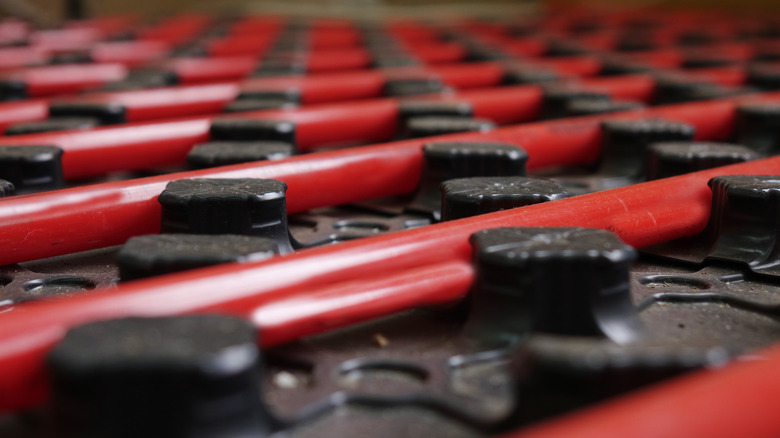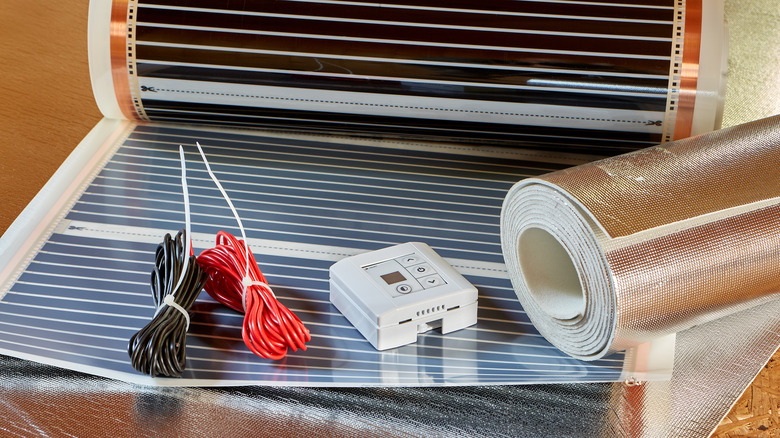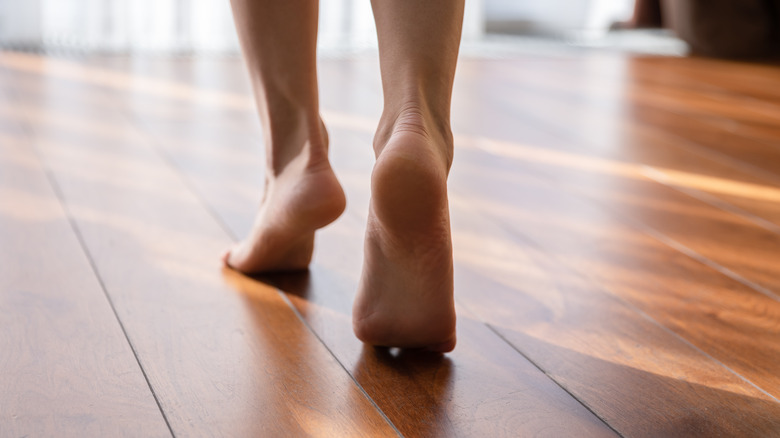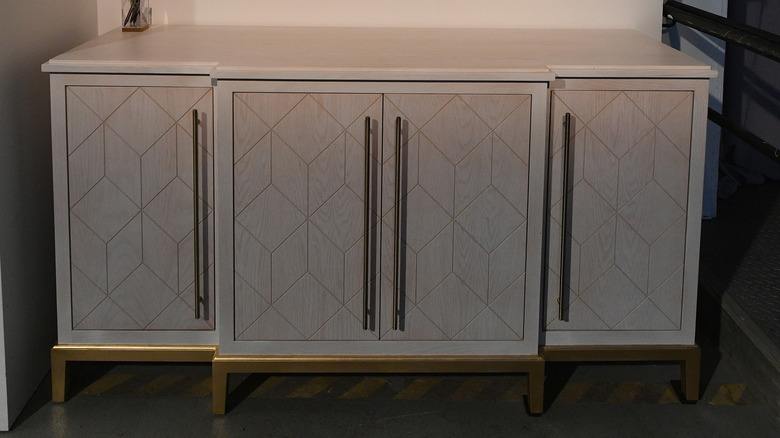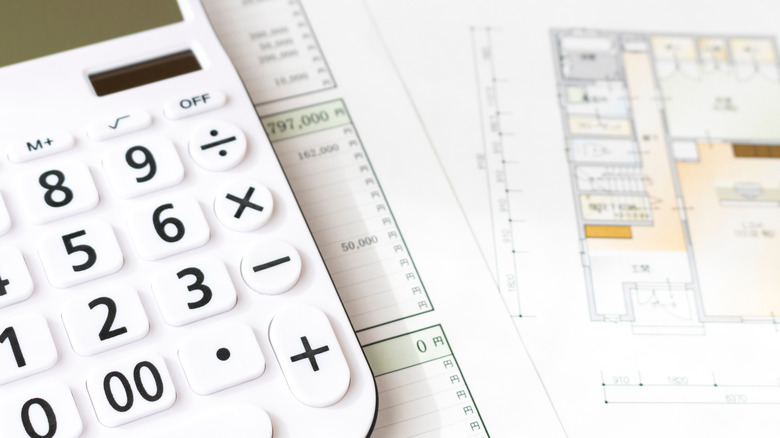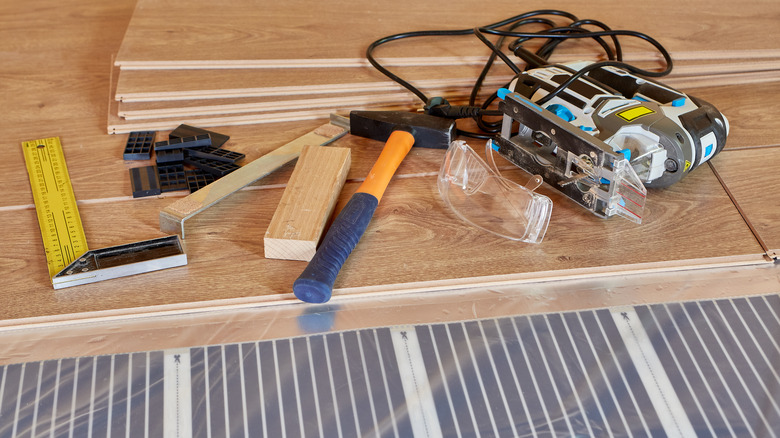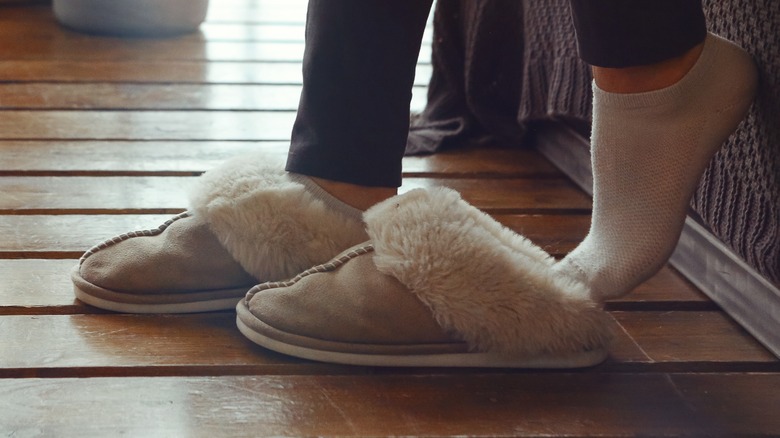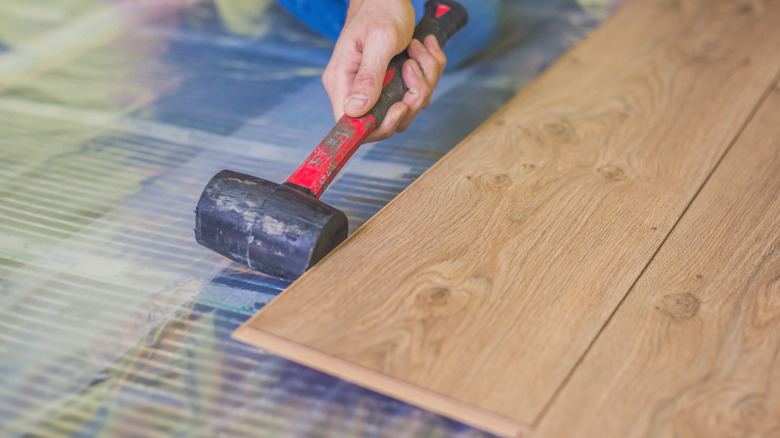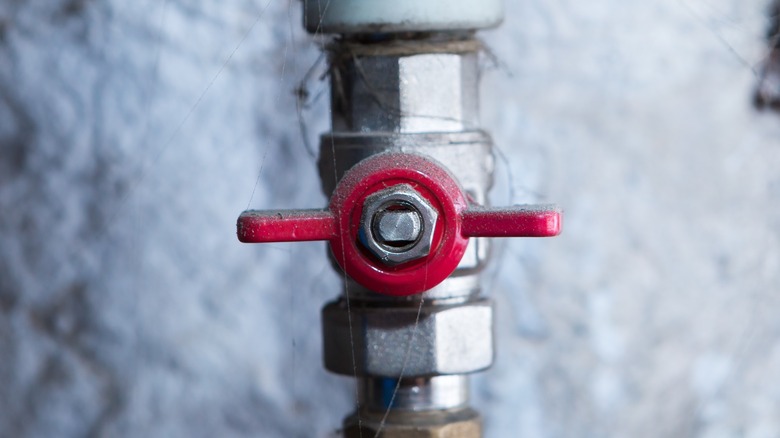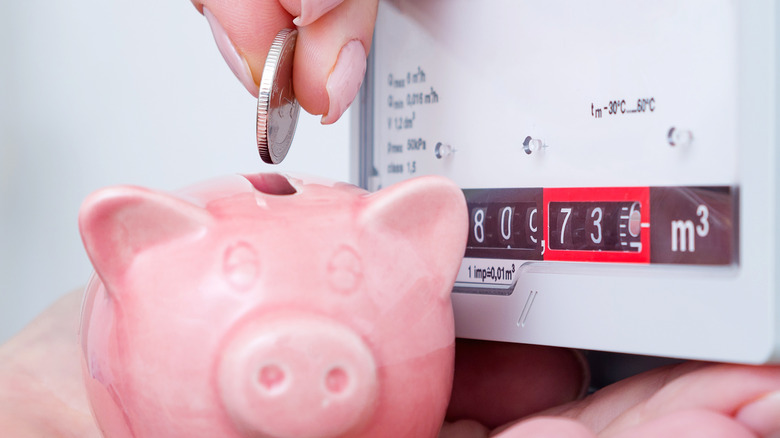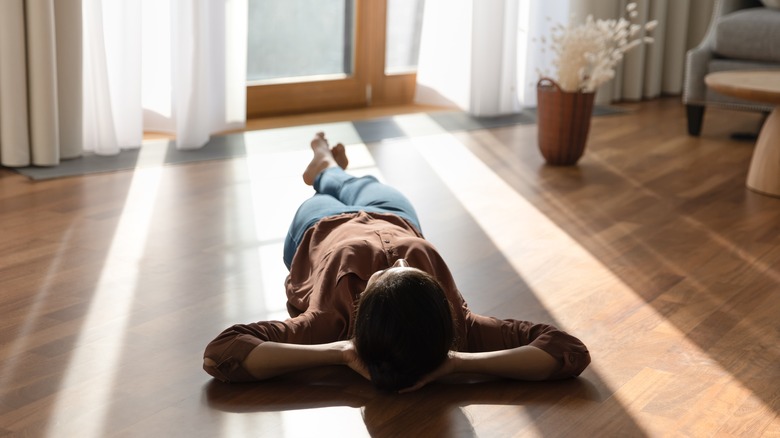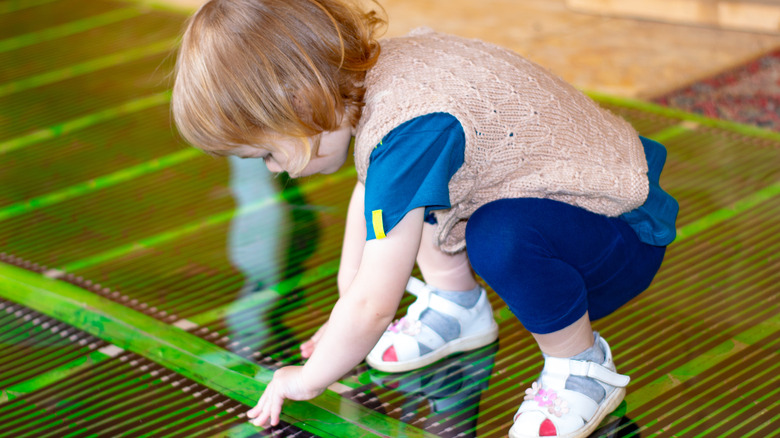Radiant Floor Heating: What To Know Before You Buy
Radiant floor heating is a system of warming up the floor and allowing the heat to radiate up to the floor's surface. Pexheat explains that, through the process of radiation, heat travels from a warmer object to a cooler one. In this case, from the surface of the floor to the people and space above it. This process is how a radiant heating system can heat your home by way of your floor.
Radiant heat can be absorbed through your skin even if the air around you is cold, allowing people to stay warm even when the air might be cooler than the surface of the floor. In addition to absorbing the radiant heat into our bodies as it leaves the surface of the floor, convection current, or air moving from lower density warm air to higher density cool air, means that heat will slowly travel up from the floor to heat a room. If you're looking into options for heating your home, keep reading to learn more about radiant floor heating.
There are three types of radiant floor heating
Electric, hydronic, and air are the three main categories of radiant heat flooring. According to United Plumbing, Heating, Air & Electric, radiant heating systems have been around in home construction for some time, but, recently, the term has become more widely used to refer to the floor heating discussed here. Let's take a closer look at the three different categories.
Electric radiant heating uses coils that heat up when electricity passes through them. When an electrical current passes through coils made from resistant material, the material heats up, and can then transfer the heat to the area around them. This is the most common method used to heat floors, and can also be used on walls and ceilings. One downside is that this method will certainly increase your electricity bill. Hydronic radiant heating systems work by pumping hot water through pipes from a boiler to create a radiant heat source. This can also be done to any surface, not just floors. While cost-effective, this method does run the risk of leaks or a pipe burst. Lastly, air radiant heating systems use air to carry radiant heat out from a heat generating source. This is the most inefficient because leaks and drafts can cause the heated air to dissipate before it reaches its destination.
Types of flooring that work best with radiant heat systems
Different types of flooring will work better than others with a radiant heating system. Generally, the most thermally conductive types of flooring will be ideal candidates. Depending on your preferences, you should be able to find a the flooring that meets your needs, as well as your style preferences.
Porcelain and ceramic tile are very heat conductive, explains Home Flooring Pros, so they're at the top of the list for radiant floor heating systems. Natural stone is also very thermally conductive — and durable, too. With a radiant floor heating system, bare feet on natural stone will feel warm rather than cold. Other options include laminate flooring, which can absorb varying temperatures better than its traditional wood counterpart. This is because laminate flooring is made from opposing layers of wood, which is similar to engineered wood, which has a similar composition of layers. Vinyl plank flooring is also compatible with a radiant heat system. You've got options!
Some floors don't do well with radiant heating systems
While there are lots of flooring options that are compatible with radiant heating systems, not all floors are designed for this type of temperature fluctuation. Wall 2 Wall Hardwood Floors explains that natural wood — especially maple and pine — will expand and contract when exposed to temperature changes, causing swelling or warping over time. Once the wood dries out, you can develop gaps between the boards, and shrinking can cause issues like creaking or even loosening of the floor boards. If you're trying to salvage some original hardwood floors or you have your heart set on maple, radiant floor heating might not be the best decision. For those that are committed to a heated hardwood surface, opt for engineered wood instead. Man-made with multiple layers for durability, but still topped with natural wood, it's a best of both worlds type of situation.
Radiant floor heating drawbacks
One major issue for some people is that you can't put large, heavy objects on a floor where a radiant heating system is installed. Getting rid of an antique armoire might not be a trade everyone is willing to make. Look After My Bills also points out that radiant floor heating can be expensive, and also requires major renovations to install. Although there are many benefits, these drawbacks might be deal breakers for some folks.
WARMUP warns that you will likely have to raise the height of your floor in order to install a radiant heating system. That means that if you're only doing one or two rooms, there could be a height difference in the floors between rooms. Additionally, the height of your floors could increase by up to an inch and a half with underlayment and insulation. In a low ceiling space, an inch and a half might not be worth it.
Cost to install
Radiant floor heating can be on the expensive end of things, even though it can save you money in the long run. While the added comfort of a radiant floor heating system can be attractive, it's a good idea to know what you're getting into before you decide to move forward. Installation costs for radiant floor heating can vary depending on what part of the country you live in and what type of radiant heating system you choose. According to Forbes, though cost effective in the long run, hydronic heating systems cost an average of $6 to $20 per square foot, compared to electric systems, which come in at $8 to $15 per square foot. Using a propane powered system to heat your floors can be the most cost effective at $6 to $18 per square foot for installation, while geothermic radiant heated floors will cost about $7 to $17 per square foot to add. Solar energy floor heating systems are the most expensive to install, costing between $18 and $25 per square foot, but are also one of the most energy-efficient routes.
How long your radiant heat flooring will last
If you're going to go through the entire process of having radiant floor heating installed, it's practical to be concerned about the longevity of your system. Considering the renovations, cost, and the planning, you'll want to know how long it will be before you need to worry about it again. Luckily, radiant floor heating lasts a while.
Most radiant heat floors will last between 30 and 45 years without needing to be replaced, according to HVACSeer. Electric systems usually come with a 25 year warranty, too. With a hydronic radiant heating system, you'll need to have a traditional boiler replaced after 15 years or so, while a tankless boiler can last 20 years or more. This means that you can install a radiant heating system and only do basic maintenance for the first 15 years or more. The pipes and hoses of a hydronic system will last 30 to 50 years without being replaced. This means that you probably won't need to touch the floor for 30 to 50 years, even if you need to replace your boiler in the meantime.
Cost to use radiant heat flooring
Radiant floor heating systems are considered to be an upgrade to most homes. If you have a good thermostat, a radiant floor heat system can save you money. Here's a cost breakdown of how much you might spend to use one in your home.
For an average 35-square foot bathroom, the cost to heat it with radiant heat flooring is about $6.60 per month, as compared to a portable heater that averages about $36.50 per month. That makes a radiant heat floor system a major saving, even with installation costs. If you use other types of heating along with the radiant heat system, a good thermostat — rather than just an on/off switch — will play a role in getting the most out of your heating system, says WarmlyYours. Using electric heating to supplement a natural gas burning furnace will shave money off your electric bill, so even if you don't use a radiant floor heating system in your entire house, a partial installation can still save you money.
It can take a while for radiant heat floors to warm up
Unlike fan-driven systems, radiant heating systems must transfer heat to the surrounding environment through absorption. This process can take much longer than a traditional heating system, and this can come as a surprise if you're used to warming up the house in a few minutes. Waiting until the temperatures drop to turn on radiant heating is a bad idea, says Best Home Heating. While you will be able to feel the floors warm up quite quickly once the system is on (almost immediately for electric, up to three hours for water-based), it can take a long time before the actual room temperature increases. For first-time use, a water-based hydronic system can take up to a week to come up to temperature after it's been turned on. Additionally, the heat can take longer to permeate the space if there is too much furniture in a room.
You can do at least some of the work yourself
With most types of HVAC systems, it's essential that you hire a professional because of the complicated venting and safety concerns. Therefore, being able to complete at least some of the radiant floor heating installation yourself is truly a money-saving bonus. Warmzone advises that an experienced DIYer can actually do most of the work to install an electric radiant heat floor system themselves. If you have enough time to thoroughly read the directions for the type of flooring you want to install, and plan out your floor heating so you get enough radiant heat to warm up the house, then you can bring the project nearly to completion. You should, however, always have a licensed electrician do the final steps of wiring the electricity to the floor heating panels. It's also best to have them do a once over to make sure everything is safe. It won't save you any money if your floor panels are shorted out or if your wiring catches fire, so best leave that part to the pros.
Some maintenance will be required
Just like other heating systems, radiant floor heating needs basic maintenance to run smoothly. Checking out the system for problems should be done periodically and preferably before it gets too cold outside. You should do an annual maintenance check and tune-up with a licensed HVAC company that specializes in radiant floor heating to make sure that everything is working properly.
An HVAC pro should service your boiler and other equipment, says Arista. For a hydronic system, your technician should also check pumps, valves, and pressure in the system to make sure that it's operating efficiently. Low pressure can reduce the amount of heat the system is able to pump out, causing it to use more energy only to under-produce heat. Generally any necessary service should be covered in your installation contract, but if it's not, you can easily find a local company that specialize in radiant floor heating systems.
Radiant floor heating is efficient
Radiant heating relies on convection, the process of moving heated air through a space, as well as radiant heat transfer. Because they're designed to work this way, they can be more efficient than other types of heating systems. The type of floor heating you have can help to determine how efficient your heating system is.
Since there is no energy loss from heat traveling through ducts or pipes, radiant floor heating is usually a more efficient option than baseboard or forced air systems, according to the U.S. Department of Energy. While electricity rates might make the electric panels a bad choice for heating your whole house, hydronic, water-based systems use very little electricity and are therefore the most efficient option, even though they are more expensive to install. The type of flooring you have can also impact how efficient your heated flooring is. Ceramic, concrete, and natural stone are very thermally conductive and also allow for heat to be "stored," because they can absorb and retain heat for longer periods of time than other materials. Furniture and carpeting is a thermal insulator, and will reduce the efficiency of a heated floor.
And it can heat your entire house
While it's usually thought of as an option for bathrooms or kitchens, radiant floor heating can heat anywhere that has a floor. In addition to being more efficient than other heating options, radiant heating doesn't have any duct work, vents, or noisy fans. Instead, it will evenly heat the whole room from the floor up.
Heidler, Inc. points out that radiant floor heating is more commonly used as needed rather than as a constant heat source. This means that it will usually use less energy. Radiant heating in the floor also takes advantage of physics by being low and allowing the less dense, heated air to rise into the rest of the room. Since forced air and baseboard heating do not always warm the actual floor up first, the floor tends to be chilly during the colder months, as the heated air quickly rises up into the ceiling and the cooler air settles near the floor. Heated floors in every room solves the problem of persistently cold winter feet.
Radiant heating is safe
There is little that can go wrong with a radiant heat flooring system that will be dangerous. Because the heated surface of the coils is never exposed, and none of the wires and vents are out in the open, it's a very safe option for children in particular, says The Earth Heating. A radiant floor heating system also eliminates lots of disturbed dust, because the lack of fans and vents mean there won't be dust, dirt, or pollen being blown around the house.
The thermal circulation that radiant floor heating relies on can actually improve air quality. Less allergies from dust and pollen also means a cleaner home. Eliminating hazards from hot radiators also means that an in-floor radiant heating system can function with less noise and less risk of fire than some conventional heating systems. Having a cleaner system translates to having a safer home.
